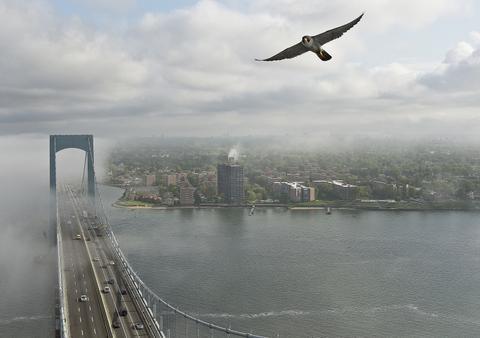
This Treasure is FAST: While internet searches may tell you that the Cheetah is the fastest animal on the planet, they are dead wrong. Today’s treasure can reach speeds faster than a moving Formula One race car. In fact, while in its spectacular dive, called a “stoop”, the Peregrine Falcon can reach speeds of up to 230 mph!
A Peregrine Falcon has two important needs … food, and a high place to live.
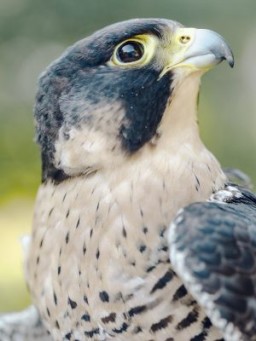 Body Designed for Hunting: Though no bigger than a crow, and weighing about 1½ lbs., a Peregrine (sometimes called a “Duck Hawk”) is the largest and most powerful species in the falcon family. It sports a blue-grey back, barred white underparts, a black head and a distinctive yellow circle around the eyes. Its pointed wings can span almost 4 feet and
Body Designed for Hunting: Though no bigger than a crow, and weighing about 1½ lbs., a Peregrine (sometimes called a “Duck Hawk”) is the largest and most powerful species in the falcon family. It sports a blue-grey back, barred white underparts, a black head and a distinctive yellow circle around the eyes. Its pointed wings can span almost 4 feet and
allows it to leisurely cruise at speeds up to 67 mph. If you are wondering why Peregrines need to cruise at such high speeds … the answer is that they eat highly mobile birds and sometimes bats.
Peregrine hunts get serious when prey is spotted during the cruising phase. At that point the high speed “stoop” begins from a great height. Due to their velocity, Peregrine Falcons aim not to catch their prey but to stun it with a blow before grabbing it as it falls. This maneuver is critical, as a hunting Peregrine is travelling so fast that a direct strike on prey could injure the Falcon itself.
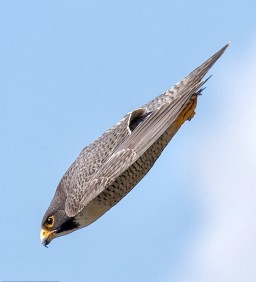 The bodies of Peregrine Falcons have many adaptations for hunting at high speeds. For starters, the shape of the Peregrine in a stoop has been compared by many to the shape of the B2 bomber. In addition, their nostrils guide shock waves of air to prevent the high pressure from damaging their lungs while they dive. This natural design actually influenced the design of the first jet engines!
The bodies of Peregrine Falcons have many adaptations for hunting at high speeds. For starters, the shape of the Peregrine in a stoop has been compared by many to the shape of the B2 bomber. In addition, their nostrils guide shock waves of air to prevent the high pressure from damaging their lungs while they dive. This natural design actually influenced the design of the first jet engines!
Peregrines also have excellent binocular vision, with resolution eight times better than that of humans, enabling them to see prey from more than a mile away. Like Owls, Peregrines have a third transparent eyelid. Its function is to spread tears and clear debris away, without obstructing vision during a high-speed stoop.
Four formidable yellow talons sport sharp, strongly curved toes. The Peregrine uses its large feet, with their powerful toes, to capture prey in the air or to knock it down. The final blow is then delivered when their unique notched beak bites through the neck of the prey to kill it. You can watch the whole hunt happening, in Rome … courtesy of David Attenborough.
Our many thanks to Thomas Kaestner for this wonderful photo of a Peregrine looking like a B2.
Digestion begins right after dinner and is a complex process involving storing food in a crop, then passing it through a two-part stomach; one section devoted to chemical breakdown of food (using acids and digestive juices) and one to mechanical breakdown of food (into smaller bits by grinding). The job of the intestinal tract is to absorb nutrients. Like owls, falcons regurgitate a pellet containing the undigestible body parts of what they have eaten. The pellet is not very recognizable because the falcon lacks the “garbage compactor” used by owls to produce a neat familiar package.
Home is a High Place: Because of the way Peregrines locate and hunt their prey, “hanging out” in high places makes a lot of sense. But they also nest in high places, such as cliffs up to 1300 feet high, choosing a ledge about a third of the way down the cliff face.
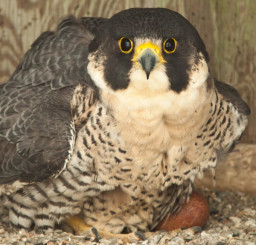 Family Life: Mated for life, Peregrines return to their nest in February, to perform incredible courtship displays during which the male executes acrobatic aerial feats designed to woo his mate. He starts by suppling the female with food, often dropping it for her to catch mid-flight …. sometimes while she is flying upside down! She needs more food than he does, as is the case with many birds. This is because the female has greater body mass than the male. Some theories speculate that this dimorphism occurs so that she can produce larger eggs and easily incubate them.
Family Life: Mated for life, Peregrines return to their nest in February, to perform incredible courtship displays during which the male executes acrobatic aerial feats designed to woo his mate. He starts by suppling the female with food, often dropping it for her to catch mid-flight …. sometimes while she is flying upside down! She needs more food than he does, as is the case with many birds. This is because the female has greater body mass than the male. Some theories speculate that this dimorphism occurs so that she can produce larger eggs and easily incubate them.
Courting, completed in March or April is followed by nest building. This activity is minimal, merely a ritualized scraping of the nest ledge to create a depression in the sand, gravel or other substrate of the nest site. “Scrape” is the name given to this rudimentary nest. No additional materials are used to house the 3-4 eggs she will lay and incubate for about 30 days; during this period the male will provide her with food. After hatching, young falcons will rely on their parents for food until they fledge, and become fully independent; this juvenile period lasts about 39 days.
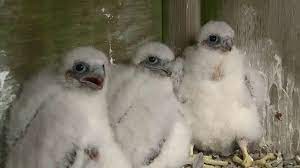
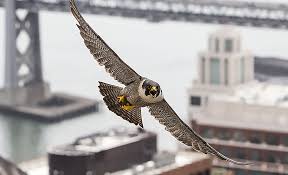 You Find Them Where? Remember the two things that Peregrines need, “food and a high place to live”? As it turns out this requirement can be met in some very unlikely settings. While cities are generally thought to be the complete antithesis of wildlife habitat, some species actually thrive in concrete jungles … and the Peregrine Falcon is one of them. They nest on window ledges of skyscrapers and feed on introduced species such as doves, pigeons, and ducks. Urban living thus meets the same needs as would the more natural setting of an ocean sea cliff!
You Find Them Where? Remember the two things that Peregrines need, “food and a high place to live”? As it turns out this requirement can be met in some very unlikely settings. While cities are generally thought to be the complete antithesis of wildlife habitat, some species actually thrive in concrete jungles … and the Peregrine Falcon is one of them. They nest on window ledges of skyscrapers and feed on introduced species such as doves, pigeons, and ducks. Urban living thus meets the same needs as would the more natural setting of an ocean sea cliff!
As a result, there are falcons in many surprising places. For example, they have been welcomed and cherished for more than 25 years at the second tallest building in Seattle. And the most famous city of skyscrapers, the “Big Apple” may now have the largest urban population of Peregrine Falcons anywhere. Not to be outdone by populations in New York City, Peregrines nest on every Hudson River bridge south of Albany, as well as on buildings and bridges in Syracuse, Rochester, Binghamton and Buffalo! These urban dwellers certainly live up to their name because both the English and scientific names of the species translates to “wandering falcon”. They also wander into More Mesa several times a year and have often been observed on the tall Eucalyptus trees near the coast. They are, if nothing else, extremely adaptable!
 We Almost Lost Them Forever: Since the first half of the twentieth century, Peregrine Falcons have been exposed to dangerous threats that almost annihilated them. At first, they were heavily persecuted by gamekeepers and landowners, who were concerned about their stocks of game-birds. Then, during WW II, in a time before our digital world was even imagined, primitive methods of delivering messages were used. Specifically, thousands of Peregrines were also killed to protect the carrier pigeons carrying “important” military messages. After the war Peregrine numbers began to recover, and a full 10 years later, legislation finally outlawed their killing.
We Almost Lost Them Forever: Since the first half of the twentieth century, Peregrine Falcons have been exposed to dangerous threats that almost annihilated them. At first, they were heavily persecuted by gamekeepers and landowners, who were concerned about their stocks of game-birds. Then, during WW II, in a time before our digital world was even imagined, primitive methods of delivering messages were used. Specifically, thousands of Peregrines were also killed to protect the carrier pigeons carrying “important” military messages. After the war Peregrine numbers began to recover, and a full 10 years later, legislation finally outlawed their killing.
However, soon after this law was introduced, the numbers of many birds of prey, including Peregrines, began to plummet. Scientists eventually discovered the culprit to be agricultural pesticides … think DDT. This toxin, used to protect crops from insects, also poisoned birds, thinned their egg shells, killed developing embryos and pushed the Peregrine to the edge of extinction. (We had our own version of this nightmare with Bald Eagles on the Channel Islands.) DDT was eventually banned in 1972. This legislation, with additional large-scale protection of nesting places and releases into the wild, allowed the Peregrine to make a full recovery. Indeed, by 1999, President Clinton had the honor of announcing that, after being pushed nearly to the edge of extinction, Peregrines had been removed from the endangered species list. Today they are still listed as a “Bird of Special Concern”.
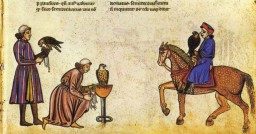 Falconry has Been Around a Long Time: The recovery of North American Peregrines was greatly aided by the activities of falconers dedicated to raptor conservation. With the sport originating somewhere between the Near and Middle East, there is ample evidence that falconry has been practiced for at least 3,500 years, (While various groups through the ages have used raptors to catch birds, falconers use only falcons for this purpose.) Falconry also became especially popular with European nobility during the Middle Ages. Little has changed fundamentally in the sport — or, as some would argue — the art of falconry since the practice first began. Today, falconry continues in the same fashion as it began thousands of years ago. (You might even remember the use of falcons in an effort to discourage Western Gulls from invading the Oakland Baseball Stadium.) Finally, although subjected to shifting popularity and restrictions, interest in falconry continues, and the intense relationship between falconers and their birds remains extremely and mysteriously strong.
Falconry has Been Around a Long Time: The recovery of North American Peregrines was greatly aided by the activities of falconers dedicated to raptor conservation. With the sport originating somewhere between the Near and Middle East, there is ample evidence that falconry has been practiced for at least 3,500 years, (While various groups through the ages have used raptors to catch birds, falconers use only falcons for this purpose.) Falconry also became especially popular with European nobility during the Middle Ages. Little has changed fundamentally in the sport — or, as some would argue — the art of falconry since the practice first began. Today, falconry continues in the same fashion as it began thousands of years ago. (You might even remember the use of falcons in an effort to discourage Western Gulls from invading the Oakland Baseball Stadium.) Finally, although subjected to shifting popularity and restrictions, interest in falconry continues, and the intense relationship between falconers and their birds remains extremely and mysteriously strong.
Stay safe … Valerie